Abstract
Spontaneous fetal death has been observed among various mammalian species after exposure to polychlorinated biphenyls (PCBs). Our exposure-based cohort study assessed the relationship between consumption of PCB-contaminated Lake Ontario sport fish and spontaneous fetal death using 1820 multigravid fertile women from the 1990-1991 New York State Angler Cohort Study. Fish consumption data were obtained from food frequency questionnaires and history of spontaneous fetal death from live birth certificates. Analyses were stratified by number of prior pregnancies and controlled for smoking and maternal age. No significant increases in risk for fetal death were observed across four measures of exposure: a lifetime estimate of PCB exposure based on species-specific PCB levels; the number of years of fish consumption; kilograms of sport fish consumed in 1990-1991; and a lifetime estimate of kilograms eaten. A slight risk reduction was seen for women with two prior pregnancies at the highest level of PCB exposure (odds ratio = 0.36; 95% CI, 0.14-0.92) and for women with three or more prior pregnancies with increasing years of fish consumption (odds ratio = 0.97; 95% CI, 0.94-0.99). These findings suggest that consumption of PCB-contaminated sport fish does not increase the risk of spontaneous fetal death.
Full text
PDF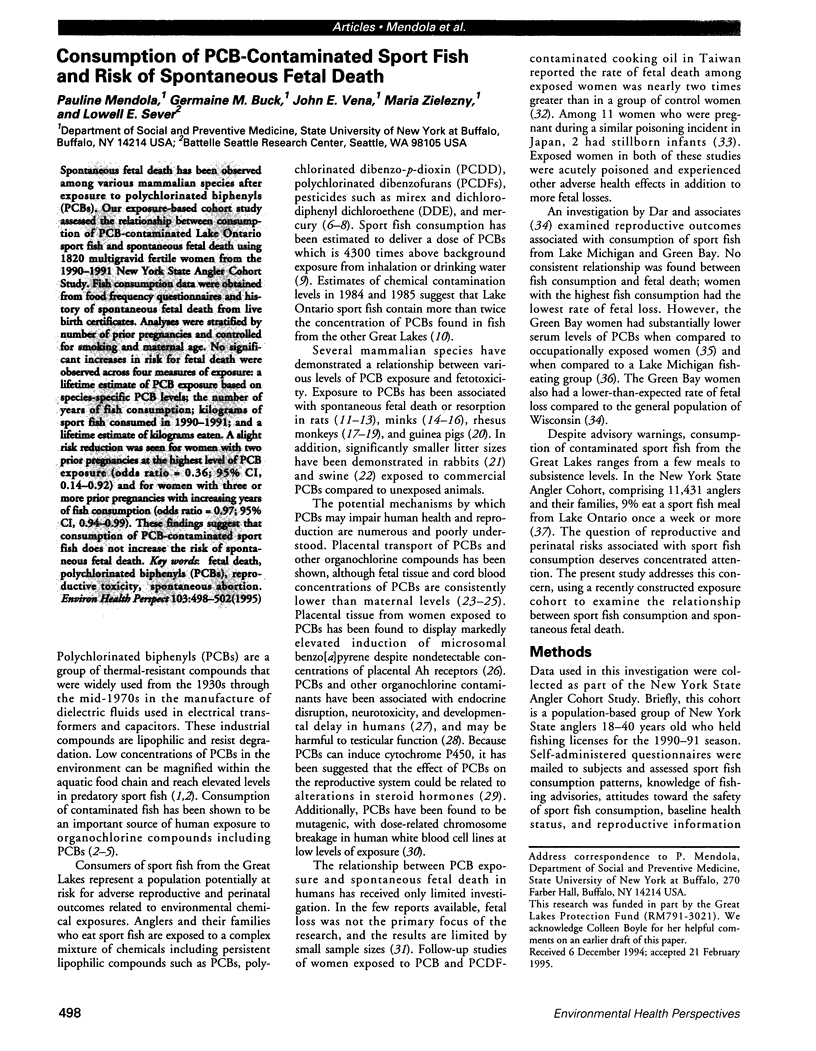
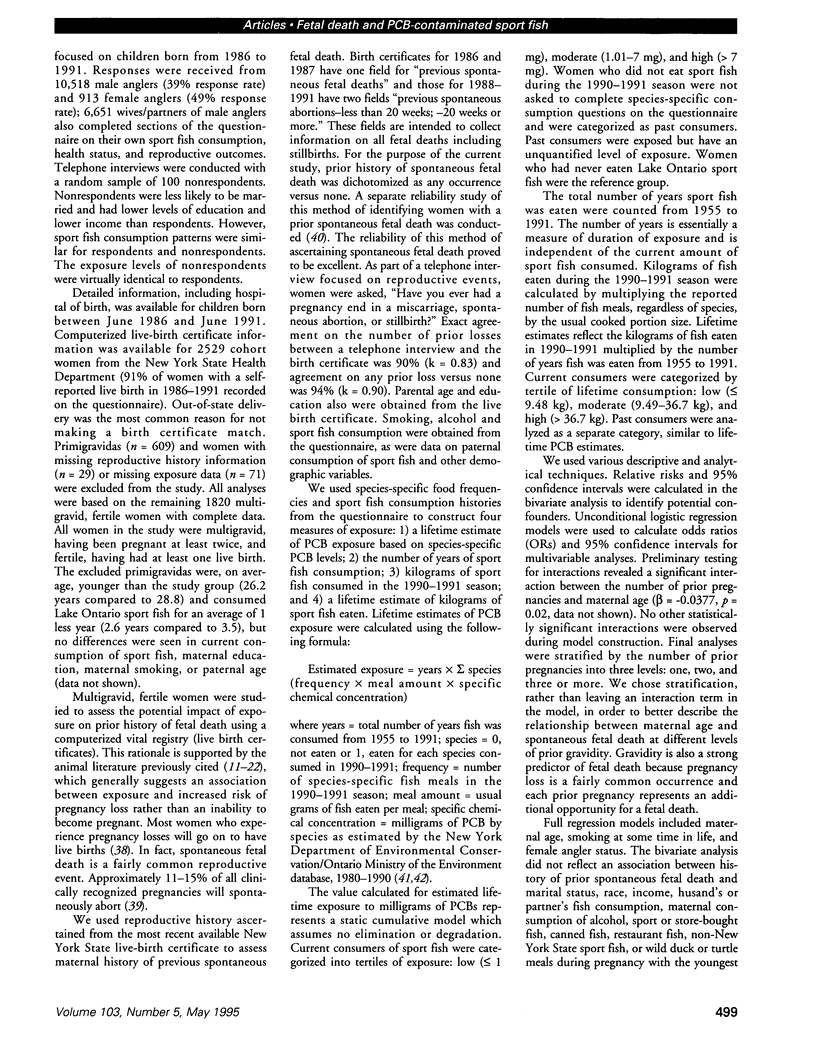
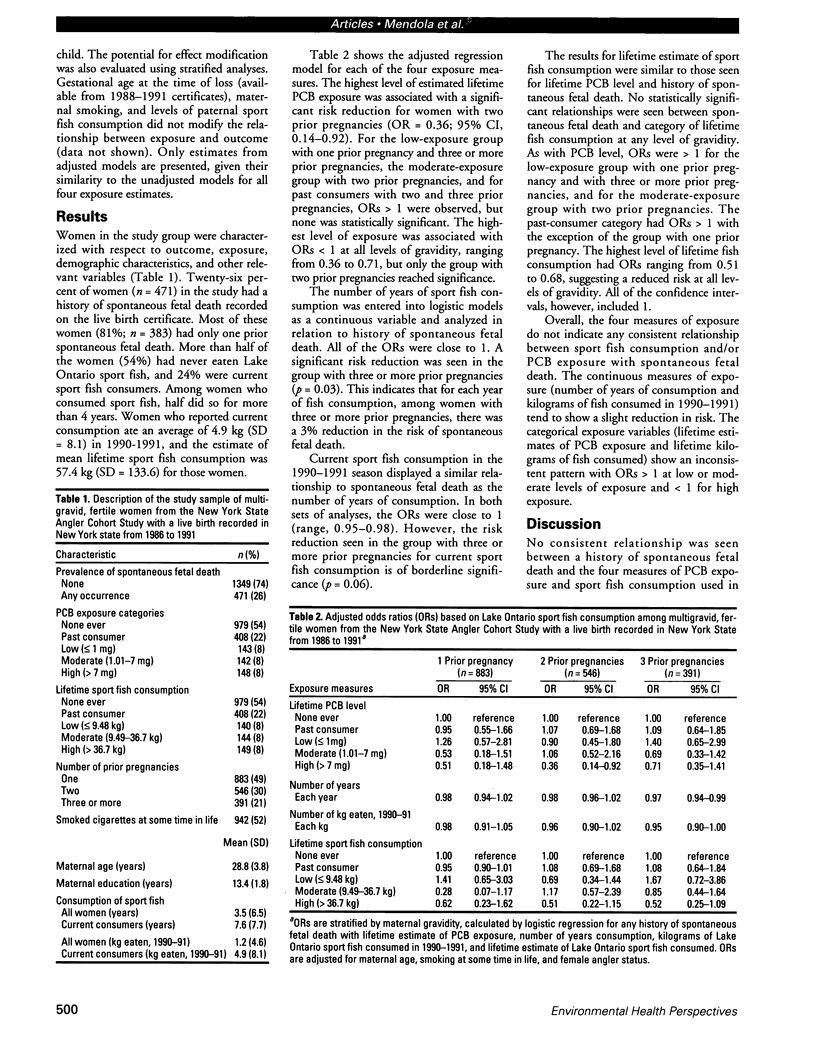
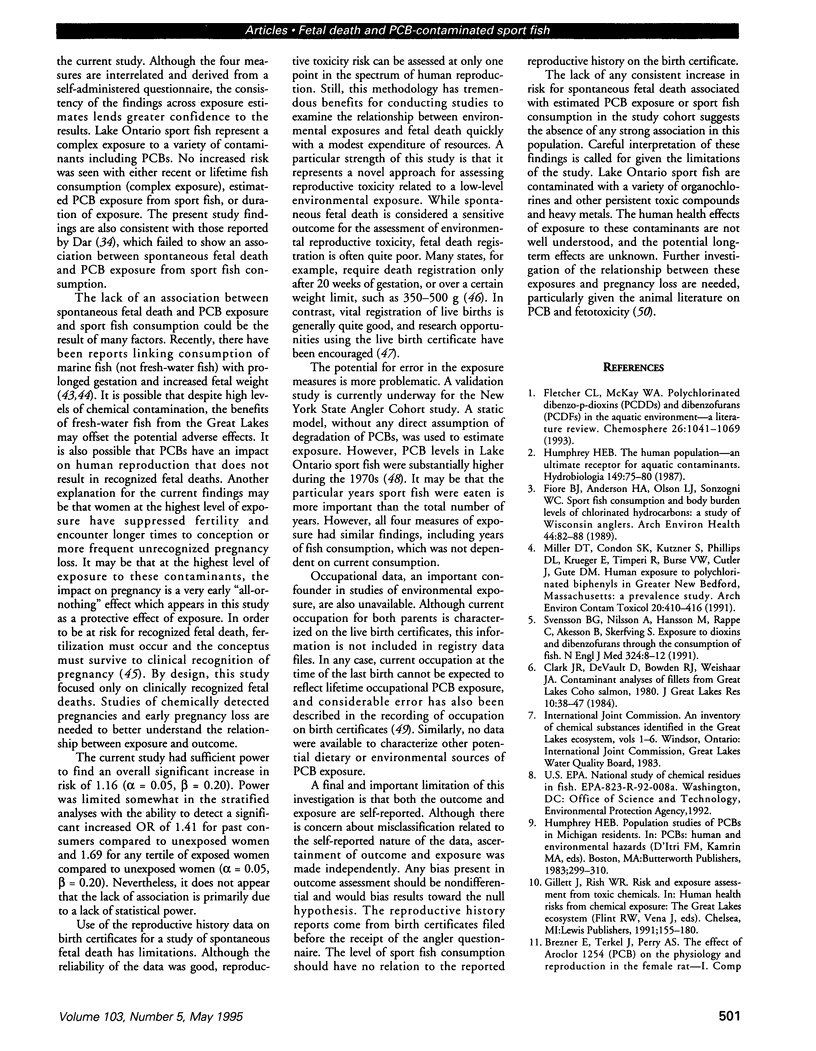
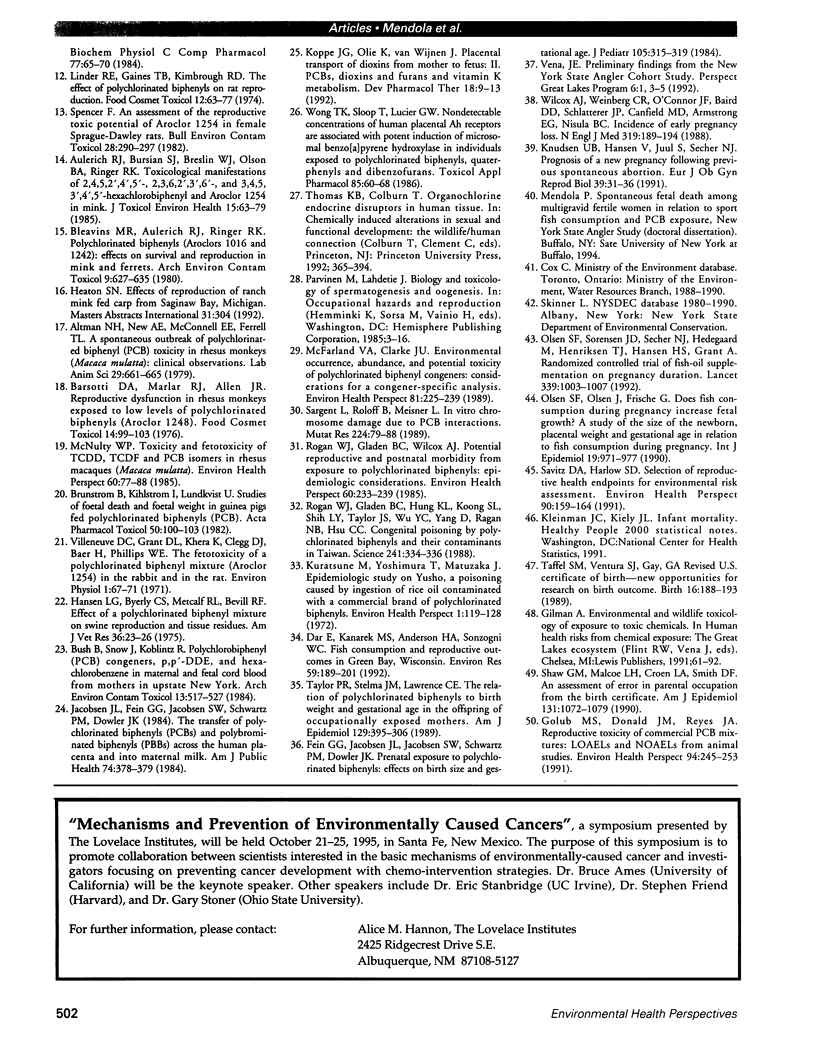
Selected References
These references are in PubMed. This may not be the complete list of references from this article.
- Altman N. H., New A. E., McConnell E. E., Ferrell T. L. A spontaneous outbreak of polychlorinated biphenyl (PCB) toxicity in rhesus monkeys (Macaca mulatta): clinical observations. Lab Anim Sci. 1979 Oct;29(5):661–665. [PubMed] [Google Scholar]
- Aulerich R. J., Bursian S. J., Breslin W. J., Olson B. A., Ringer R. K. Toxicological manifestations of 2,4,5,2',4',5'-, 2,3,6,2',3',6'-, and 3,4,5,3',4',5'-hexachlorobiphenyl and Aroclor 1254 in mink. J Toxicol Environ Health. 1985;15(1):63–79. doi: 10.1080/15287398509530636. [DOI] [PubMed] [Google Scholar]
- Barsotti D. A., Marlar R. J., Allen J. R. Reproductive dysfunction in rhesus monkeys exposed to low levels of polychlorinated biphenyls (Aoroclor 1248). Food Cosmet Toxicol. 1976 Apr;14(2):99–103. doi: 10.1016/s0015-6264(76)80251-9. [DOI] [PubMed] [Google Scholar]
- Bleavins M. R., Aulerich R. J., Ringer R. K. Polychlorinated biphenyls (Aroclors 1016 and 1242): effects on survival and reproduction in mink and ferrets. Arch Environ Contam Toxicol. 1980;9(5):627–635. doi: 10.1007/BF01056942. [DOI] [PubMed] [Google Scholar]
- Brunström B., Kihlström I., Lundkvist U. Studies of foetal death and foetal weight in guinea pigs fed polychlorinated biphenyls (PCB). Acta Pharmacol Toxicol (Copenh) 1982 Feb;50(2):100–103. doi: 10.1111/j.1600-0773.1982.tb00948.x. [DOI] [PubMed] [Google Scholar]
- Bush B., Snow J., Koblintz R. Polychlorobiphenyl (PCB) congeners, p,p'-DDE, and hexachlorobenzene in maternal and fetal cord blood from mothers in Upstate New York. Arch Environ Contam Toxicol. 1984 Sep;13(5):517–527. doi: 10.1007/BF01056331. [DOI] [PubMed] [Google Scholar]
- Dar E., Kanarek M. S., Anderson H. A., Sonzogni W. C. Fish consumption and reproductive outcomes in Green Bay, Wisconsin. Environ Res. 1992 Oct;59(1):189–201. doi: 10.1016/s0013-9351(05)80239-7. [DOI] [PubMed] [Google Scholar]
- Fein G. G., Jacobson J. L., Jacobson S. W., Schwartz P. M., Dowler J. K. Prenatal exposure to polychlorinated biphenyls: effects on birth size and gestational age. J Pediatr. 1984 Aug;105(2):315–320. doi: 10.1016/s0022-3476(84)80139-0. [DOI] [PubMed] [Google Scholar]
- Fiore B. J., Anderson H. A., Hanrahan L. P., Olson L. J., Sonzogni W. C. Sport fish consumption and body burden levels of chlorinated hydrocarbons: a study of Wisconsin anglers. Arch Environ Health. 1989 Mar-Apr;44(2):82–88. doi: 10.1080/00039896.1989.9934380. [DOI] [PubMed] [Google Scholar]
- Golub M. S., Donald J. M., Reyes J. A. Reproductive toxicity of commercial PCB mixtures: LOAELs and NOAELs from animal studies. Environ Health Perspect. 1991 Aug;94:245–253. doi: 10.1289/ehp.94-1567963. [DOI] [PMC free article] [PubMed] [Google Scholar]
- Hansen L. G., Byerly C. S., Metcalf R. L., Bevill R. F. Effect of a polychlorinated biphenyl mixture on swine reproduction and tissue residues. Am J Vet Res. 1975 Jan;36(1):23–26. [PubMed] [Google Scholar]
- Jacobson J. L., Fein G. G., Jacobson S. W., Schwartz P. M., Dowler J. K. The transfer of polychlorinated biphenyls (PCBs) and polybrominated biphenyls (PBBs) across the human placenta and into maternal milk. Am J Public Health. 1984 Apr;74(4):378–379. doi: 10.2105/ajph.74.4.378. [DOI] [PMC free article] [PubMed] [Google Scholar]
- Knudsen U. B., Hansen V., Juul S., Secher N. J. Prognosis of a new pregnancy following previous spontaneous abortions. Eur J Obstet Gynecol Reprod Biol. 1991 Mar 21;39(1):31–36. doi: 10.1016/0028-2243(91)90138-b. [DOI] [PubMed] [Google Scholar]
- Koppe J. G., Olie K., van Wijnen J. Placental transport of dioxins from mother to fetus. II. PCBs, dioxins and furans and vitamin K metabolism. Dev Pharmacol Ther. 1992;18(1-2):9–13. [PubMed] [Google Scholar]
- Kuratsune M., Yoshimura T., Matsuzaka J., Yamaguchi A. Epidemiologic study on Yusho, a Poisoning Caused by Ingestion of Rice Oil Contaminated with a Commercial Brand of Polychlorinated Biphenyls. Environ Health Perspect. 1972 Apr;1:119–128. doi: 10.1289/ehp.7201119. [DOI] [PMC free article] [PubMed] [Google Scholar]
- Linder R. E., Gaines T. B., Kimbrough R. D. The effect of polychlorinated biphenyls on rat reproduction. Food Cosmet Toxicol. 1974 Feb;12(1):63–77. doi: 10.1016/0015-6264(74)90322-8. [DOI] [PubMed] [Google Scholar]
- McFarland V. A., Clarke J. U. Environmental occurrence, abundance, and potential toxicity of polychlorinated biphenyl congeners: considerations for a congener-specific analysis. Environ Health Perspect. 1989 May;81:225–239. doi: 10.1289/ehp.8981225. [DOI] [PMC free article] [PubMed] [Google Scholar]
- McNulty W. P. Toxicity and fetotoxicity of TCDD, TCDF and PCB isomers in rhesus macaques (Macaca mulatta). Environ Health Perspect. 1985 May;60:77–88. doi: 10.1289/ehp.856077. [DOI] [PMC free article] [PubMed] [Google Scholar]
- Miller D. T., Condon S. K., Kutzner S., Phillips D. L., Krueger E., Timperi R., Burse V. W., Cutler J., Gute D. M. Human exposure to polychlorinated biphenyls in Greater New Bedford, Massachusetts: a prevalence study. Arch Environ Contam Toxicol. 1991 Apr;20(3):410–416. doi: 10.1007/BF01064412. [DOI] [PubMed] [Google Scholar]
- Olsen S. F., Olsen J., Frische G. Does fish consumption during pregnancy increase fetal growth? A study of the size of the newborn, placental weight and gestational age in relation to fish consumption during pregnancy. Int J Epidemiol. 1990 Dec;19(4):971–977. doi: 10.1093/ije/19.4.971. [DOI] [PubMed] [Google Scholar]
- Olsen S. F., Sørensen J. D., Secher N. J., Hedegaard M., Henriksen T. B., Hansen H. S., Grant A. Randomised controlled trial of effect of fish-oil supplementation on pregnancy duration. Lancet. 1992 Apr 25;339(8800):1003–1007. doi: 10.1016/0140-6736(92)90533-9. [DOI] [PubMed] [Google Scholar]
- Rogan W. J., Gladen B. C., Hung K. L., Koong S. L., Shih L. Y., Taylor J. S., Wu Y. C., Yang D., Ragan N. B., Hsu C. C. Congenital poisoning by polychlorinated biphenyls and their contaminants in Taiwan. Science. 1988 Jul 15;241(4863):334–336. doi: 10.1126/science.3133768. [DOI] [PubMed] [Google Scholar]
- Rogan W. J., Gladen B. C., Wilcox A. J. Potential reproductive and postnatal morbidity from exposure to polychlorinated biphenyls: epidemiologic considerations. Environ Health Perspect. 1985 May;60:233–239. doi: 10.1289/ehp.8560233. [DOI] [PMC free article] [PubMed] [Google Scholar]
- Sargent L., Roloff B., Meisner L. In vitro chromosome damage due to PCB interactions. Mutat Res. 1989 Sep;224(1):79–88. doi: 10.1016/0165-1218(89)90006-2. [DOI] [PubMed] [Google Scholar]
- Savitz D. A., Harlow S. D. Selection of reproductive health end points for environmental risk assessment. Environ Health Perspect. 1991 Jan;90:159–164. doi: 10.1289/ehp.90-1519470. [DOI] [PMC free article] [PubMed] [Google Scholar]
- Shaw G. M., Malcoe L. H., Croen L. A., Smith D. F. An assessment of error in parental occupation from the birth certificate. Am J Epidemiol. 1990 Jun;131(6):1072–1079. doi: 10.1093/oxfordjournals.aje.a115599. [DOI] [PubMed] [Google Scholar]
- Spencer F. An assessment of the reproductive toxic potential of Aroclor 1254 in female Sprague-Dawley rats. Bull Environ Contam Toxicol. 1982 Mar;28(3):290–297. doi: 10.1007/BF01608510. [DOI] [PubMed] [Google Scholar]
- Svensson B. G., Nilsson A., Hansson M., Rappe C., Akesson B., Skerfving S. Exposure to dioxins and dibenzofurans through the consumption of fish. N Engl J Med. 1991 Jan 3;324(1):8–12. doi: 10.1056/NEJM199101033240102. [DOI] [PubMed] [Google Scholar]
- Taffel S. M., Ventura S. J., Gay G. A. Revised U.S. certificate of birth--new opportunities for research on birth outcome. Birth. 1989 Dec;16(4):188–193. doi: 10.1111/j.1523-536x.1989.tb00896.x. [DOI] [PubMed] [Google Scholar]
- Taylor P. R., Stelma J. M., Lawrence C. E. The relation of polychlorinated biphenyls to birth weight and gestational age in the offspring of occupationally exposed mothers. Am J Epidemiol. 1989 Feb;129(2):395–406. doi: 10.1093/oxfordjournals.aje.a115143. [DOI] [PubMed] [Google Scholar]
- Wilcox A. J., Weinberg C. R., O'Connor J. F., Baird D. D., Schlatterer J. P., Canfield R. E., Armstrong E. G., Nisula B. C. Incidence of early loss of pregnancy. N Engl J Med. 1988 Jul 28;319(4):189–194. doi: 10.1056/NEJM198807283190401. [DOI] [PubMed] [Google Scholar]
- Wong T. K., Sloop T., Lucier G. W. Nondetectable concentrations of human placental Ah receptors are associated with potent induction of microsomal benzo[a]pyrene hydroxylase in individuals exposed to polychlorinated biphenyls, quaterphenyls, and dibenzofurans. Toxicol Appl Pharmacol. 1986 Aug;85(1):60–68. doi: 10.1016/0041-008x(86)90387-x. [DOI] [PubMed] [Google Scholar]


